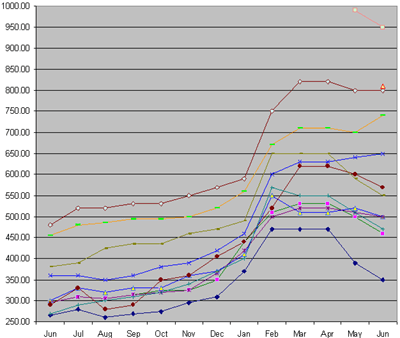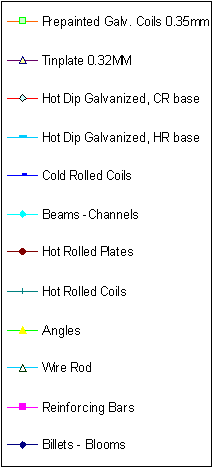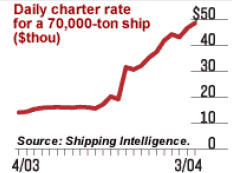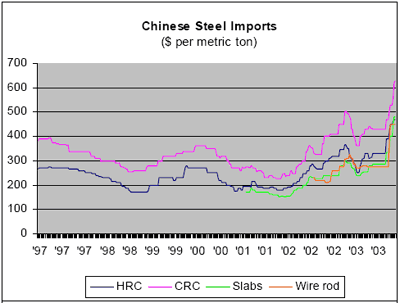|
- by HYLSAMEX |
|||||||
| During he past year, the prices
of iron-bearing raw materials and consequently, of steel as well, have
been on the rise as never before. The world market for iron and steel,
coming out of a recession that lasted several years, is being affected
by a number of factors and things are getting "curiouser and
curiouser".
For a time it seemed that the steel industry would stay in the dumps. With world stock markets having fallen, jobs on the decline and industrial demand at the lowest level in decades, steel producers took unprecedented steps to try and stay alive. We all know of course that many of the companies, including some of the major steel producers, are no longer in operation. Bankruptcy or mergers with other, stronger organizations has reduced the number of steel producers. In an effort to preserve domestic market and stave off the flow of lower-priced steel imports from abroad, the U.S. government enacted the Section 201 Import Tariff legislation, which was allowed to expire this past November. Still, there were companies filing for bankruptcy protection, even as world steel demand began to increase. There are a number of factors affecting the price and availability of both steelmaking raw materials and of finished steel. The easiest explanation is the effect that China is having on world markets, although there are other underlying reasons of equal importance. The perspective is clearer however if we look first at China. The China Syndrome China's apparent steel consumption grew by 50 million tons (25.4% over 2002) to 247.25 million tons. Crude steel output grew by 40.65 million tons (22.4% over 2002) to 222.34 million tons, making China the first country in the world to exceed the 200 million ton per year mark. It's almost necessary to repeat those numbers for them to sink in. China, from one year to the next, produced 40.65 MILLION TONS MORE steel. All this was happening while the recessive world economy was still in
the doldrums, but China's booming demand for not only steel but just
about everything else, gave the world steel industry a needed lift.
Global crude steel production grew in 2003 by 59.6 million tons (6.6%)
to 962.5 million tons. Nearly 87% of this increase, 51.5 million tons,
was due to China - either as production or imports from other nations.
China last year consumed more than one-fourth of the world's total steel
output. |
|||||||
|
The boom in 2003 is continuing into this year and will likely be at similar levels of growth through 2005 as well, based on China's current 5-year plan. It is estimated that China's rapid industrialization rate will require growing to 310 million tons of steel in the year 2010. The positive effects are obvious; China's increased demand for steel and steel products gives a shot in the arm to steel producers, prices have recovered and growth is now steady after nearly three years of stagnation or decline. The negative effects are what have everyone on the edge of their seats. China's seemingly endless need for materials as they develop infrastructure at a furious pace has many people wondering how long it can continue, and at what price. As China draws in raw materials and finished products, the strain on availability and prices has become critical. How long can it continue? |
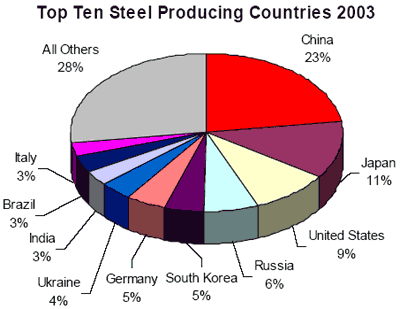 |
||||||
| Metallics Overview | |||||||
| Steel scrap
Over the past 25 years, and despite occasional spikes, the top grades of steel scrap have remained fairly stable in price. In the late 1970's and early 1980's, prices for # 1 HMS and Shredded scrap grades fluctuated in the $90-110/ton range. From the mid-1980's to the end of 1993, the range was from $65-110/ton, reflecting a major down-cycle in the steel industry, but otherwise in the same range as before. From 1993 to 1998, scrap prices became fairly consistent in a range of $125-150/ton until most nations found themselves in the midst of an economic recession, which lasted (for the steel industry) until just last year. Scrap prices from 1998 to 2002 ranged from as low as $65 to just upwards of $ 130/ton. Last year, #1 HMS began the year at around $105/ton and by the end of December it had reached $ 160/ton. Shredded scrap started the year at $112 and hit $180 by year's end. Demand had increased not only due to major import volumes by Chinese steel producers, but also by increased production of steel elsewhere, much of which was destined for China. This year, the upward trend continues. |
|||||||
| For the first time in a
quarter-century, y-axis values on graphs depicting scrap prices have
been rescaled. Prices for #1 HMS reached $240/too by late February and
Shredded scrap hit $260. This of course means that export prices for
scrap delivered to Asian markets easily exceeded $300+ per ton with
delivered prices of over $350 being usual. Steel mills in Indonesia and
Thailand were paying $350/ton c+f for HMS #1 and #2 (80:20 mix).
Some have claimed that city governments were welding down their sewer drain covers and people were chaining their cars and bicycles to posts to avoid theft for resale as scrap. Perhaps this is just hyperbole. There is no doubt however that at such high prices, obsolete scrap will readily find the way into the market. |
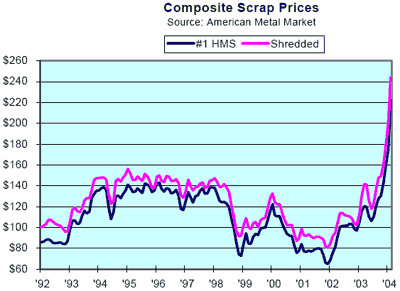 |
||||||
| Still, with the
pressure exerted by Chinese demand driving prices higher, many nations
have begun to take control measures. The Ukraine, many of the European
nations, Korea and the U. S. have considered partial restrictions on
imports. Quotas are being considered to assure domestic producers have
first access to available scrap supplies before exports are permitted.
Numerous other countries such as India have reduced or suspended import
duties on scrap, DRI and steel products in an effort to contain the
rising prices.
With per-ton steel prices growing by $15-20 per month, it is now common to see raw materials surcharges applied to the total as well, passing on the increased scrap costs in order to salvage profitability. |
|||||||
| Iron Ore | |||||||
| Obviously, with steel production finally on the increase, demand for iron ore likewise has grown. The major ore suppliers, after holding prices during the recent recession, have increased ore prices this year. This affects integrated steel producers as well as DRI and HBI producers, although not to the same degree as scrap pricing. Again, China is demanding (and receiving) huge volumes of iron ore to
feed their existing steel mills at the new production levels. Chinese
iron ore imports grew 32% over the past year, to 148 million tons.
Brazil, Sweden, Australia as well as minor suppliers, including Mexico,
are shipping iron ore pellet, lump and fines to Chinese producers at
attractive prices. Indian iron ore exports to China went from 23 million
tons last year to 29 million tons this most recent fiscal year. Half of
that volume was on contract basis, while half was on the spot market at
constantly increasing prices which are now well above $65/ton. |
|||||||
|
|||||||
| China has tremendous need of iron ore since as a nation they have relatively minor reserves, not nearly sufficient for the volume of steel needed for industrialization. Yet as with scrap and steel, the upward pressure on iron ore prices has also affected the world's steel producers. | |||||||
| Alternate
Iron
With scrap prices through the ceiling, pig iron and HBI suppliers are having banner years as well. While these products traditionally sell at a premium over the top grades of scrap, it was no secret that for the past 2-3 years producers were selling at prices at or even below production costs. Steel production declines worldwide also reduced demand for pig iron from Brazil and the former Soviet block. As a result, pig iron was being sold for whatever price could be obtained. New HBI plants, which had just come into operation as the steel industry sank into a recession, had little choice but to sell low or shut down. With production costs of around $100 per ton in some cases, it was not uncommon for HBI to be sold for $80/ton. Today of course the situation has changed dramatically, and those producers who weathered the storm are now able to recover what they lost in the down market. There has been a resurgence in DRI and HBI production, despite increased costs for both iron ore and natural gas which have increased costs. Supply is strained however, just as it is with steel scrap. HBI producers currently have a 6-month backlog. Orders taken in March are for September delivery in most cases. Prices have been holding based on the price of scrap, with producers selling for $270-300/ton. Pig iron producers as well are selling in the $300/ton range and no product is currently available. There is very little pig iron or HBI sold on long-term contract, most tends to be short-term or spot market. Producers however have been honoring previously arranged HBI contracts, delivering at prices of $130140/ton despite the nearly doubled current prices. Those companies lucky enough to have onsite DRI production facilities are now in an enviable position. As scrap prices climb, those mills that were accustomed to using 20-35% DRI in their furnaces were able to increase DRI use (and consequently, steel quality) while staying out of the scrap market. When compared with steel scrap, DRI and HBI are suddenly the bargain of the year. |
|||||||
| The Return of the Dinosaur | |||||||
| In light of the situation facing EAF steel producers today, it appears that the integrated steel producer is now in an enviable position. The lower margins and reduced operating costs typical for the new minimill steel operations have been (at least temporarily) wiped out by raw materials costs. Suddenly the integrated mill is more profitable, although there are factors brought on by the "China Syndrome" which also affect the BF-BOF mills. China's steel industry is also consuming more coke than before, increasing prices and restricting availability. Iron ore, as mentioned previously, has gone up in price due to market demand and supplier increases. On the whole however, the integrated mills appear to be in a better position at the moment than their more modem EF -based counterparts. A latent problem for these producers is that many of their largest customers, including the automotive industry, have already declined to pay the current elevated steel market prices. In at least one case, a steel producer was taken to court by an auto producer to force delivery at much lower contracted prices, even if the producer was losing money because of dramatically increased costs. |
|||||||
| Shipping
Transportation costs are also up dramatically, which affects not only steel producers but also everyone anywhere who wants to ship (or receive) any product or material. While the rest of the world was looking for the light at the end of the tunnel, it turns out the light was a train (or ship or plane) bound for China. As China both expanded production and continued to build infrastructure, demand for raw materials and finished products grew to such a level that it seemed all the world's ships were sailing for China at the same time. This not only affects prices to China but in general. Scrap demand by China increased and prices went up accordingly. Ships became scarce and shipping rates went up. The $6-12/ton you might have paid last year for shipping might now be $35-40/ton - IF you can schedule delivery. HBI from Venezuela bound for China recently shipped at $40/ton and reports of scrap going to Korea from the U.S. east coast were double that rate. |
|||||||
|
|||||||
| What Is Steel Worth? | |||||||
| A few years ago there was so much steel being traded internationally and with demand reduced, prices plummeted. With slabs selling for less than $190/ton at the time, it was not uncommon for producers to shut down operations and simply import and resell rather than producing at costs above that level. Things have changed. Russian HRC, which was selling for $280/ton FOB last September, was going at over $500/ton in March. In the U.S., HRC recently ranged from $370-420/ton plus scrap surcharges of from $30-90/ton added to that. Billet in Asian markets is going for $450/ton. European rebar prices are around €380-400/ton. By the time you are reading this, these prices may not even be accurate, so quickly are changes being made. While some speculate that if the trend continues, rebar prices will exceed $500/ton by Q3 of this year and cold rolled coils will be $600 or more, it appears that the market will cool down before that will happen. |
|||||||
| Possible
Scenarios
In very simple terms, the current price structure for both steel and steelmaking raw materials cannot be sustained. While it is unlikely anytime soon that we will see prices return to the levels of last year (below $100/ton), it is fairly a certainty that the recent jumps in prices will soon be followed by similar drops as prices begin to roll back. This should occur for a number of reasons:
|
|||||||
|
|||||||
| The other scenario,
although more dramatic, is less likely. This involves China pulling back
from the import markets as they become more self-sustaining, causing a
sudden glut of perhaps in excess of 100 million tons of steel on the
world market.
Were this to happen today, for example, prices would plummet and producers would scramble to unload huge volumes of still they had hoped would bring high prices on the Chinese market. We would essentially make a quick return to a steel recession much larger than the one from which the industry just recently emerged. As mentioned, the Chinese government has already begun to take steps to bring the situation back into proportion while still being able to continue their ambitious industrial development programs. At some point, China will shift gears as they begin to achieve their goals, and as their apparent consumption of steel approaches more consistent and sustainable levels, both demand and pricing will find their levels as well. An additional consideration involves China's lack of raw materials. Combined with the need for vast amounts of basic infrastructure goods, it is conceivable that we will begin to see new Chinese-owned companies appearing around the world. These companies would capitalize on locally /regionally available materials for producing steel or other commodities for export to China. The cost of producing slabs, for example, in a country with adequate
supplies and prices of iron ore, coal or gas and other inputs would be
more attractive in the long run for satisfying China's demands. In
addition to being less expensive for all concerned to ship one item
(slabs) back to China instead of all the required components, such
projects would also be more attractive to the local economies. |
|||||||
| So What About China? | |||||||
| China is not going to go away. China is the world's largest steel producer and will continue to be for years to come. It would not be an exaggeration to say that world-class steel producers will be able to plan their future based on the direction that China takes. Industrial development is on a fast track and will continue to absorb much of the world's raw materials and production capabilities. Once China is able to assume more and more of their internal production requirements, pressure will ease. Shipping is a clear example: the Chinese government is currently building what will be the world's largest shipbuilding facility. Once Chinese ships become part of the international fleet of commercial vessels, the current high pricing and lack of ships in the rest of the world will begin to ease. There will be ships to take your widgets to Wembley, despite what the Chinese may or may not be importing and exporting. It is truly an unusual time for steel producers certainly no one envisioned this type of a "recovery" during the down market of the past few years. While China will continue to play a fundamental role over the next year or so, it remains to be seen whether the industrialized nations can bring about a steady recovery in industrial demand to maintain future growth. |
|||||||
|
Source: HYL |
|||||||
